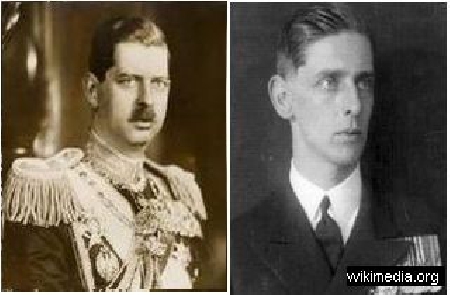Political rivalries: King Carol II and Prince Nicolae
A difficult person, Carol II would eagerly start a conflict even with members of his own family, such as his brother Nicolae.

Steliu Lambru, 02.09.2013, 12:06
There are few individuals in Romanian history who have been so disliked as King Carol II, and even fewer who made themselves the object of such abhorrence. In politics King Carol has been criticized by both leading figures of Romanian democracy, such as Iuliu Maniu, and by the far right. King Carol II was a vainglorious and authoritarian figure, and reactions to his autocratic rule were quick to pile up. 10 years after his ascension to the throne, Carol II left Romania in a state of agony, bereft of big chunks of its territory in the east, west and south. Carol II was the type that would declare open conflict even to members of his own family. One of them was his brother, Prince Nicolae.
The fourth born of King Ferdinand and Queen Marie, Nicolae was baptized by Tsar Nikolay II of Russia himself, who would be executed by the Bolshevik Government in 1918. Although he received the education of a prince who would one day claim the throne of Romania if the occasion demanded it, Prince Nicolae obstinately turned down every opportunity to get more involved in politics and take the path of royalty, and the opportunities were quite a few. Historian Ioan Scurtu explains that one of the main features of Prince Nicolae was his complete lack of ambition towards becoming a monarch.
Ioan Scurtu: “Prince Nicolae was the second son of the six children Queen Marie and King Ferdinand had during their marriage. Prince Nicolae had no royalty ambitions. He had no intention to take the throne, even when Prime Minister Marghiloman suggested Prince Nicolae be proclaimed heir to the throne in 1918, when Carol married Zizi Lambrino and was on the brink of being written out of the lineage. Later on, in the regency period, between 1927 and 1930, Queen Marie insisted that Prince Nicolae be appointed first regent so that he should be the de facto leader of the Royal House of Romania. But, as I’ve said, Prince Nicolae had no such ambition”.
In any family it is commonplace to see brothers quarrelling, and the Royal Family was no exception. In the case of Carol and Nicolae, historian Ioan Scurtu says there are two reasons accounting for their rivalry. The first was Carol’s chronic arrogance. Carol wanted everyone around him to swear blind allegiance to him and to everything he did, even to his own personal choices and to his love life.
Ioan Scurtu: “On June 6th, 1930, when Carol returned to Romania from his self-imposed exile, Prince Nicolae welcomed him back with arms wide open and hugged him in public at Cotreceni Palace. I think the conflict between them is rooted in a more personal matter, namely Prince Nicolae’s marriage to a woman who was not royalty, something that was frown upon by the Royal House of Romania. Carol sought to bring his brother Nicolae back “on the right path”, although he himself was living with his partner Elena Lupescu, who was far from the stuff of nobility and whom in the end he did not marry. Nicolae however did marry Ioana Dolete-Saveanu in December 1931. Responding to Carol’s suggestion, Interior Minister Constantin Argetoianu asked the Mayor of Tohani village, where the civil marriage was performed, to bring forth the civil registry. He summoned his private notary and asked him to copy every record of all the marriages except that between Prince Nicolae and Ioana Saveanu”.
The other source of rivalry between the two brothers had to do with Nicolae’s political choices. Ioan Scurtu says this aspect inflamed Carol and kept the conflict alive.
Ioan Scurtu: “The second cause of the conflict is tied to the political choices of Prince Nicolae. He got very close to the Legionnaire movement, which in April 1936 held a Congress that approved the set up of the famous death squads, entrusted with taking out their political opponents, including Elena Lupescu. To make things worse, Prince Nicolae publicly expressed his sympathy towards the legionnaires. Against this backdrop, the Legionnaire Movement published a manifesto extolling Prince Nicolae and his standpoint against this “young madam” who was seen as a bane for the country. In April 1937, at Carol’s initiative, a gathering of the Privy Council decided to cast off Prince Nicolae from the Royal Family. It was a very sensitive issue, because Nicolae was accused of marrying a member of the lower class, in other words, he had breached the statute of the Royal House”.
The end of the war also marked the end of the Romanian dynasty, with King Carol II already in exile since 1940. He was later joined by the other members of the Royal Family. Nicolae was the one who took the first step towards reconciliation with his brother.
Ioan Scurtu: “Although he had been banned from the Royal House, although Carol had had an extremely bad attitude towards him, Prince Nicolae was the only member of the Royal Family to attend the funerals of Carol II. Neither his son Michael I, nor his sisters or other close relatives did that. Prince Nicolae was an interesting character in Romanian politics. He was not at all interested in replacing Carol as King of Romania, though he resented Elena Lupescu’s involvement in politics.”
The rivalry between King Carol II and Prince Nicolae did not go as far as the one between the King and Corneliu Codreanu, the head of the Iron Guard, which ended in Codreanu’s assassination. But the whimsical king did not shy from using against his brother all the tricks he could possibly use in order to impose his will.






























